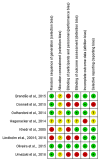The efficacy of transcranial direct current stimulation and transcranial magnetic stimulation for chronic orofacial pain: A systematic review
- PMID: 31415654
- PMCID: PMC6695170
- DOI: 10.1371/journal.pone.0221110
The efficacy of transcranial direct current stimulation and transcranial magnetic stimulation for chronic orofacial pain: A systematic review
Abstract
Background: Transcranial Direct Current Stimulation (tDCS) and Transcranial Magnetic Stimulation (TMS) have been described as promising alternatives to treat different pain syndromes. This study evaluated the effects of TMS and tDCS in the treatment of chronic orofacial pain, through a systematic review.
Methods: An electronic search was performed in major databases: MEDLINE, Scopus, Web of Science, Cochrane, Embase, LILACS, BBO, Open Gray and CINAHL. The eligibility criteria comprised randomized clinical trials (RCTs) that applied TMS or tDCS to treat chronic orofacial pain. The variables analyzed were pain, functional limitation, quality of life, tolerance to treatment, somatosensory changes, and adverse effects. The risk of bias was assessed through the Cochrane Collaboration tool, and the certainty of evidence was evaluated through GRADE. The protocol was registered in the PROSPERO database (CRD42018090774).
Results: The electronic search resulted in 636 studies. Thereafter, the eligibility criteria were applied and the duplicates removed, resulting in eight RCTs (four TMS and four tDCS). The findings of these studies suggest that rTMS applied to the Motor cortex (M1), the dorsolateral prefrontal cortex (DLPFC) and the secondary somatosensory cortex (S2) provide adequate orofacial pain relief. Two studies reported significant pain improvement with tDCS applied over M1 while the other two failed to demonstrate significant effects compared to placebo.
Conclusions: rTMS, applied to M1, DLPFC or S2, is a promising approach for the treatment of chronic orofacial pain. Moreover, tDCS targeting M1 seems to be also effective in chronic orofacial pain treatment. The included studies used a wide variety of therapeutic protocols. In addition, most of them used small sample sizes, with a high risk of biases in their methodologies, thus producing a low quality of evidence. The results indicate that further research should be carried out with caution and with better-standardized therapeutic protocols.
Conflict of interest statement
The authors have declared that no competing interests exist.
Figures
Similar articles
-
Transcranial Magnetic and Direct Current Stimulation (TMS/tDCS) for the Treatment of Headache: A Systematic Review.Headache. 2019 Mar;59(3):339-357. doi: 10.1111/head.13479. Epub 2019 Jan 23. Headache. 2019. PMID: 30671941
-
Transcranial Neurostimulation (rTMS, tDCS) in the Treatment of Chronic Orofacial Pain.Prog Neurol Surg. 2020;35:125-132. doi: 10.1159/000511134. Epub 2020 Oct 12. Prog Neurol Surg. 2020. PMID: 33045706 Review.
-
Non-invasive brain stimulation in chronic orofacial pain: a systematic review.J Pain Res. 2018 Aug 1;11:1445-1457. doi: 10.2147/JPR.S168705. eCollection 2018. J Pain Res. 2018. PMID: 30122975 Free PMC article. Review.
-
Evaluation of a home-based transcranial direct current stimulation (tDCS) treatment device for chronic pain: study protocol for a randomised controlled trial.Trials. 2015 Apr 23;16:186. doi: 10.1186/s13063-015-0710-5. Trials. 2015. PMID: 25902771 Free PMC article. Clinical Trial.
-
Noninvasive transcranial direct current stimulation (tDCS) for the treatment of orofacial pain.Neuro Endocrinol Lett. 2016 Oct;37(5):368-372. Neuro Endocrinol Lett. 2016. PMID: 28231681
Cited by
-
Difference in Analgesic Effects of Repetitive Transcranial Magnetic Stimulation According to the Site of Pain.Front Hum Neurosci. 2021 Nov 26;15:786225. doi: 10.3389/fnhum.2021.786225. eCollection 2021. Front Hum Neurosci. 2021. PMID: 34899224 Free PMC article.
-
Repetitive Transcranial Magnetic Stimulation of the Primary Motor Cortex beyond Motor Rehabilitation: A Review of the Current Evidence.Brain Sci. 2022 Jun 10;12(6):761. doi: 10.3390/brainsci12060761. Brain Sci. 2022. PMID: 35741646 Free PMC article. Review.
-
Deciphering pain: molecular mechanisms and neurochemical pathways-challenges and future opportunities.Front Mol Biosci. 2024 Nov 14;11:1382555. doi: 10.3389/fmolb.2024.1382555. eCollection 2024. Front Mol Biosci. 2024. PMID: 39629040 Free PMC article. Review.
-
Efficacy and safety of repetitive transcranial magnetic stimulation with different frequencies on neuropathic orofacial pain: a systematic literature review and meta-analysis.J Oral Facial Pain Headache. 2024 Jun;38(2):48-67. doi: 10.22514/jofph.2024.013. Epub 2024 Jun 12. J Oral Facial Pain Headache. 2024. PMID: 39801095 Free PMC article.
-
Neuromodulation Techniques in Children with Super-Refractory Status Epilepticus.Brain Sci. 2023 Oct 30;13(11):1527. doi: 10.3390/brainsci13111527. Brain Sci. 2023. PMID: 38002487 Free PMC article. Review.
References
-
- Macfarlane TV, Blinkhorn AS, Davies RM, Kincey J, Worthington HV. Oro-facial pain in the community: prevalence and associated impact. Community Dent Oral Epidemiol. 2002;30(1):52–60. Epub 2002/03/29. . - PubMed
-
- Riley JL 3rd, Gilbert GH. Orofacial pain symptoms: an interaction between age and sex. Pain. 2001;90(3):245–56. Epub 2001/02/24. . - PubMed
Publication types
MeSH terms
LinkOut - more resources
Full Text Sources
Medical



